New Wahoo KICKR CORE 2

At first glance, there’s not much to see here for current owners of the Wahoo KICKR CORE. There are a few features like better connectivity and race mode trickled down from the flagship KICKR smart trainers. But, current KICKR CORE users, who are looking for an upgrade, are not necessarily the target market for this new CORE 2. Rather, Wahoo and Zwift have been partnering to reduce the complexity of getting started with indoor riding and offer a better onboarding experience for people new to bringing their bikes inside to ride on Zwift or other platforms. In support of this mission, I am considering this new CORE 2 from the perspective of the newbie, rather than someone who has been Zwifting since the beta days.
Moving Indoors
I find myself frequently in conversations encouraging people to try riding indoors. I live in Western New York where we joke that our winter lasts 6 months. For many recreational cyclists, this means hanging up the bike until the snow is gone and the salt brine on the roads has been washed away by rain. I attempt to convince them that staying active in the winter riding indoors will make for more fun in our glorious summers that are hard earned by enduring lake effect snow. However, their eyes quickly glaze over when I start describing the equipment and apps involved in getting setup to ride indoors.
My first question is whether or not someone considering riding indoors is comfortable taking off their rear wheel. If not, the updated KICKR ROLLR is a viable option, especially since it now reports a more accurate estimated power value to Zwift rather than relying on Zwift’s zPower. This update has made for a better Zwifting experience using the ROLLR. The ROLLR makes it very easy to mount your bike and has a natural ride feel.

If the person is comfortable taking their rear wheel off, then this opens a whole new experience that direct drive trainers like the KICKR CORE afford so well. The KICKR CORE has long been the leading option for an entry level direct drive trainer, and the upgrades for the CORE 2 product and packaging improve the onboarding experience for the person new to riding indoors, especially on Zwift.
Improved Setup and Installation
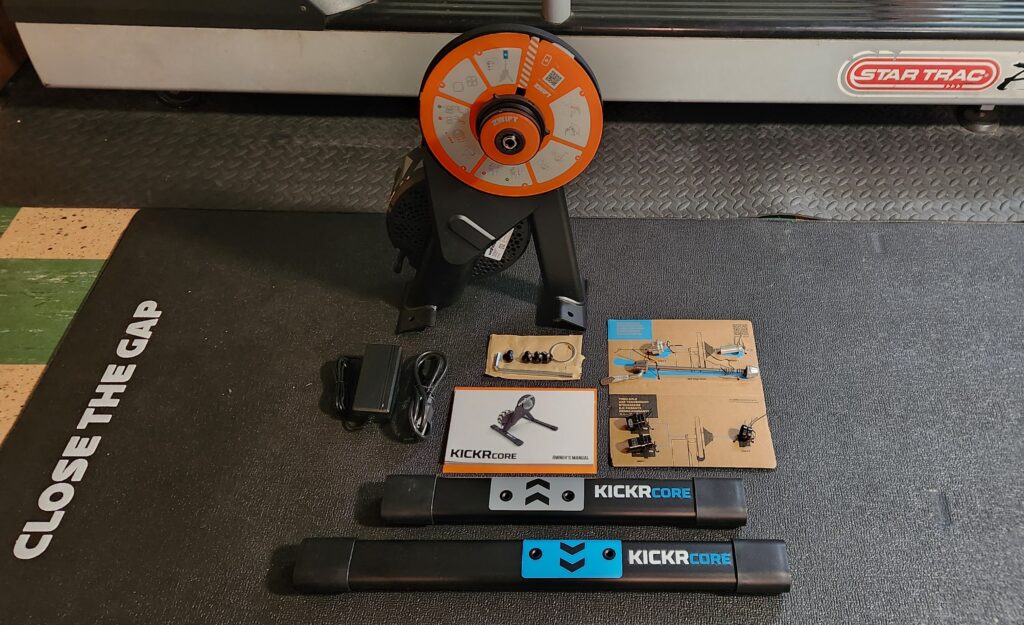
Wahoo has benefitted greatly from their partnership with Zwift in reducing the complexity of the initial assembly and bicycle mounting for their trainers. Color coding, assembly diagrams that are not text heavy, QR codes for assembly videos, and cardboard measuring tools for determining the appropriate axel adapters are some of the examples of the careful thought and assembly testing design engineers put in to make the setup process less of a headache.
These changes in packaging and instructions may seem trivial to the seasoned cyclists. However, keep in mind that the CORE V2 could be a person’s first smart trainer (and maybe their last because of its durability). We would want that initial onboarding experience to be as easy as possible to get them moving on the bike as soon as possible. Note below the color coding and direction arrows for matching the alignment of the support feet.
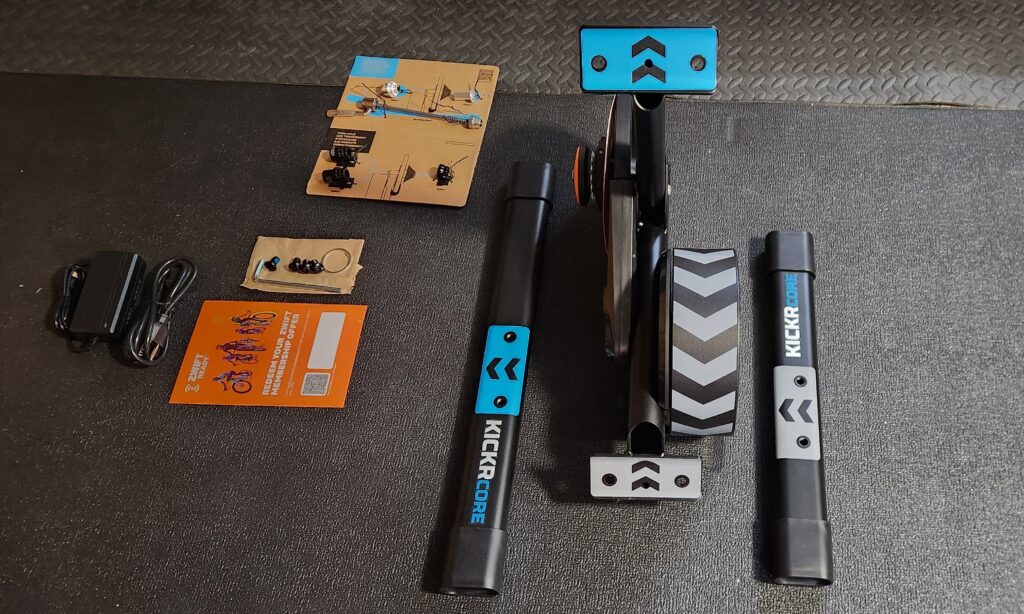
The axel adapters are fixed to a cardboard measuring tool, rather than loose in a plastic bag, making it easier to identify axel type, measure a bikes dropouts, and determine the correct axel adapters. These easy to follow directions for measurement and assembly are directly taken from Zwift products and packaging.
Benefits of Zwift Cog and Virtual Shifting
The KICKR CORE 2 is now available with an 11-speed cassette or a Zwift bundle that includes the new Zwift Cog and Click, both for the price of $549.99. The Zwift choices leads you to riding on their platform with virtual shifting and a monthly ($19.99/mo) or annual ($199.99/yr) subscription. The 11-speed cassette choice leads you to figuring out your bike’s drivetrain compatibility and potentially having to buy a separate compatible cassette for riding on the CORE 2. The freehub body on the CORE 2 can accept 8 thru 13 speed HG-compatible cassettes. Wahoo is taking a market researched guess here that the most common drivetrains for cyclists interested in an entry level smart trainer are 11 speed. This reduced complexity of the CORE 2 is definitely steered toward getting new riders on Zwift, which may be the best option for onboarding the uninitiated to virtual riding and racing. Arguably, Zwift is more user friendly for the uninitiated compared to other available virtual riding platforms.
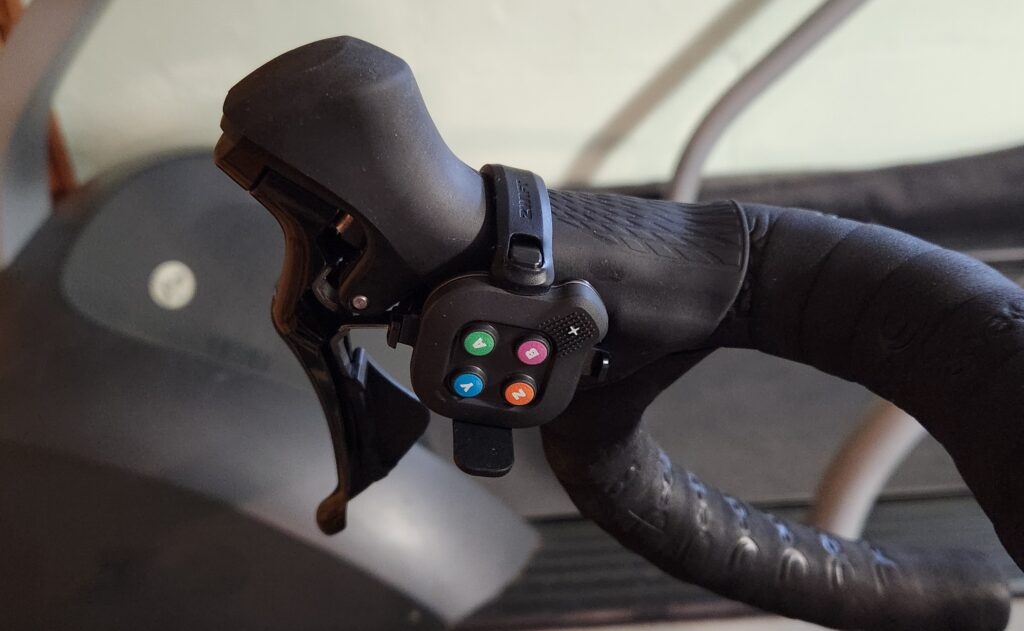
The new Zwift Click has the full functionality of the Zwift Play controllers that are being phased out. Pictured above (right Click) and below (left Click), the new Zwift Click includes a left and a right controller that can be mounted wherever works best for the user. Here, I have them mounted on the hoods, but they also can be mounted on the bar tops. The new Click accommodates flat bars in contrast to the discontinued Zwift Play that were designed exclusively for drop bars.

Although, the Zwift Cog locks users into virtual shifting on Zwift, it greatly reduces the complexity of adjusting the bike’s rear derailleur to shift cleanly on a trainer mounted cassette. Almost invariably, the offset of the cassette relative to the dropouts is slightly different on a bike compared to any trainer and requires adjusting the rear derailleur. The updated orange Zwift Cog makes mounting a bicycle so much easier on a single cog, especially with the dial that allows for changing the Cog’s offset position. Alignment is as easy as putting your derailleur in a middle gear, mounting the bike on the trainer, and then adjusting the Cog offset for optimal chain alignment. No adjustment needs to be made to your bike’s rear derailleur.
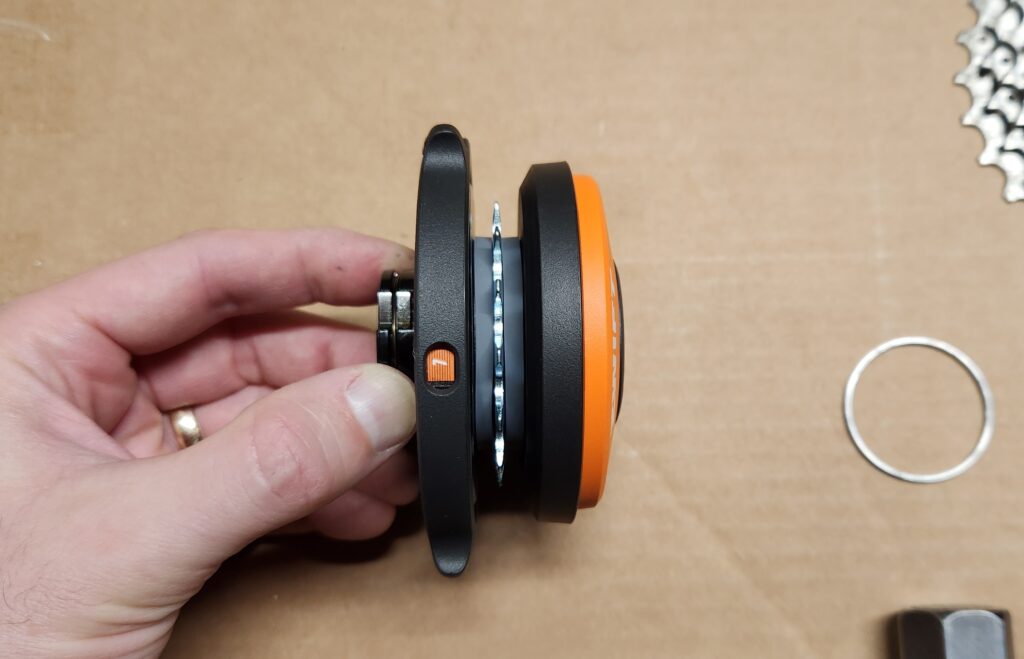
Easier Connectivity and Updates
The KICKR CORE 2 has been upgraded for Wi-Fi, Bluetooth, and ANT+ connectivity. Wahoo also has introduced KICKR Bridge, which pairs your devices to the trainer through Bluetooth and broadcasts a single Bluetooth connection to whatever device you are using to control the trainer. The KICKR Bridge is particularly useful for devices like Apple TV that have a limited number of Bluetooth connections.
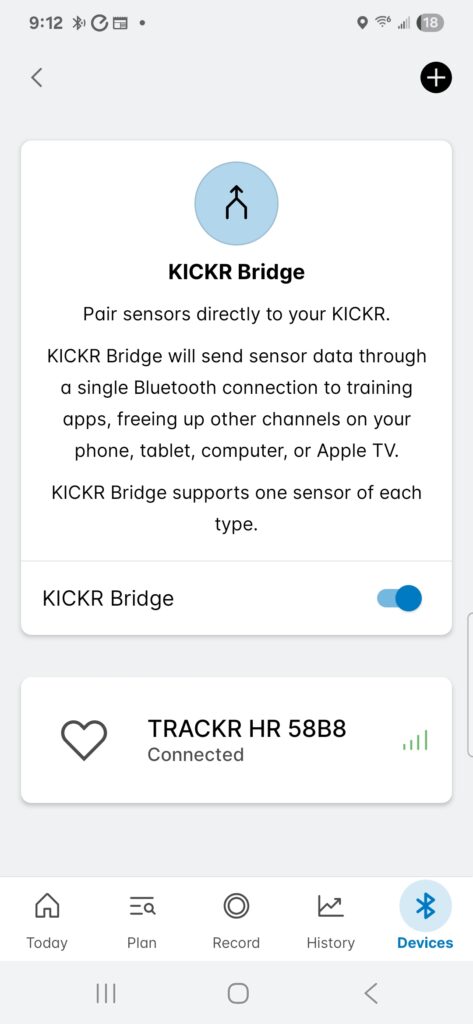
Bluetooth devices like a heart rate monitor can be paired through KICKR Bridge from the Wahoo app. Above is a screenshot from my phone showing the connection of my TRACKR heart rate monitor with the KICKR CORE 2.
Indoor Racing on a Budget
The KICKR CORE 2 also received the “race mode” upgrade, which is an accelerated rate of data reporting to devices and software like Zwift. The faster data speed means less lag between the power generated at the cranks and the power reported in game. For those racing on platforms like Zwift, race mode allows for more responsiveness to changes in pack dynamics and terrain. Race mode can be turned on or off in the Wahoo app. I have not found any down side to leaving race mode on all the time.
Final Thoughts
I see these updates to the KICKR CORE 2 as primarily improving the onboarding experience of someone new to riding indoors on a smart trainer. Wahoo has streamlined the process for getting on Zwift with much less friction than before with the KICK CORE 2 with Zwift Cog and Click. For those not ready or willing to commit to a Zwift subscription or interested in another virtual cycling platform, Wahoo offers the KICKR CORE 2 with an 11-speed cassette only. However, all the historical obstacles remain with the cassette option, such as drivetrain compatibility, potential need for a chain whip and lock ring tool to swap cassettes, and potential for rear derailleur adjustment.
In February, Rouvy started supporting virtual shifting using the Zwift Click. So, you are not necessarily locked into Zwift if you opt for a trainer with the Zwift Cog and Click. Time will tell if other popular virtual cycling platforms will support Zwift Click as well.




So I am in the market for a new trainer. My H3 board decided to underestimate power by10+% and I am tired of doing the math. Reinvest in another H3 or go with the Core 2? Thoughts from the group are appreciated as the outdoor season is approaching closing in the Great White North of WI
Thanks
I don’t have any familiarity with the H3, but I can attest to the durability and accuracy of three generations of KICKRs and now two generations of KICKR COREs. They are built to last.
I’d switch to a Kickr or Jet Black. Lots of additional features (virtual shifting, race mode, etc.) and better supported.
FWIW, I’m still running an H1 and kinda waiting for it to die so I can justify upgrading to the new Core.
That’s impressive in some ways to have that experience, but equally that’s a lot of trainers. I’m still on my OG neo from 2016. ZWIFT reports 25,000km on it, so probably nearer to 30,000km in reality. Never needs calibrating and only thing I needed to do was add a small rubber ring behind the magnet at 20,000k to stop a slight squeak. Still reports power consistently 10-15w lower than the 4 quarq spider PMs I’ve used with it, which to me is well within expectations.
I’ve killed 3 or 4 Kickrs, and I have repaired a couple more (for other people) and I think it is more accurate to say that they have worked pretty hard from generation to generation to fix most of the problems that have limited the lifespan of previous iterations. They still have some glaring weaknesses, such as no overvoltage protection on a product that shares the same DC connector type with a family of products with different voltage requirements, but they have improved the belt and bearing design problems of the earlier models.
Decided to go with the Core 2 mainly b/c price with some cc rewards,etc through REI. Have found this to be a very good trainer with a few adjustments to make after almost a decade on a Saris. The main thing is how quiet the Core is- wow- my wife came down and asked if I was going to start riding b/c she could not hear the trainer going. I have found that with the 11 speed cassette (Rouvy guy not Zwifting) the gear I am riding in is about 2 smaller than what I would normally ride- oh first world problems. But it does great, seems to be accurate when compared with my Favero’s. So I am sold it on so far. Thanks for all the responses from folks
I have an H3 that was used 2x I am trying to offload. I bought 2. One for Trek SC rim version and one for my disc brake bike. Sold the Trek and only used it 2x on the trainer. If you are near DC area we might be able to meet up if you are interested.